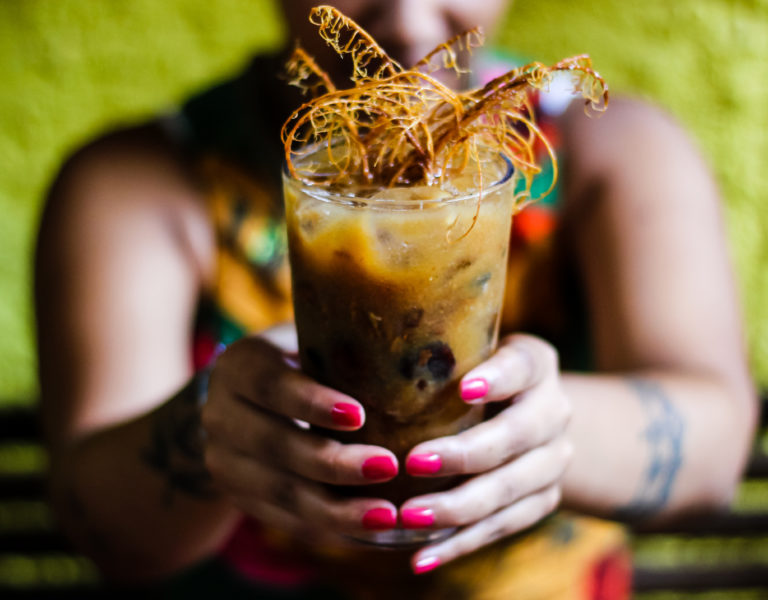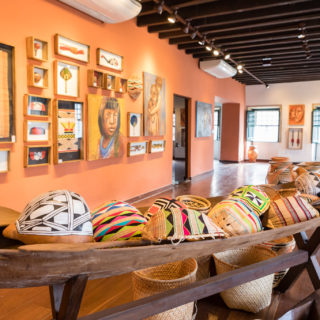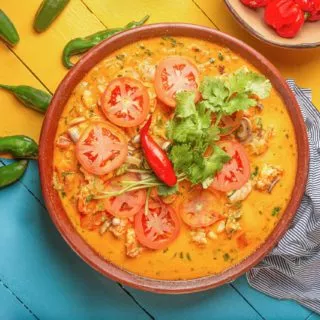
Big or small, sweet or sour, in a popsicle or a roska: discover the delights of northeastern fruits
Getting to know the local culture of a place is for sure a unique life experience. There are some ways to go through this experience and one of them is through gastronomy. Here at Visit Salvador da Bahia, we always tell you the traditions of each dish and the best places to taste them. Now, it’s time to learn a little more about Northeastern fruits, some of the sweetest and most succulent gastronomic delights in Bahia.
Do you know all the fruits on this list? In this text, we’ll tell you some curiosities and, of course, where to find each one. In other words, while you know more about each fruit, we’ll give you sightseeing tips from a list of cool places around town.
Jenipapo – the classic liqueur of the São João festivals
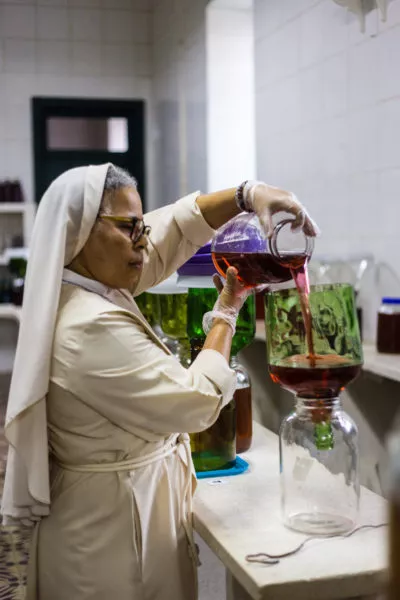
The jenipapo pulp has a strong smell and is edible, but it is most appreciated in the form of jams, sweets, syrups and liqueur. At June festivals in Bahia, the jenipapo liqueur is the most traditional and the most famous are produced in the Recôncavo baiano, by hand, in barrels that are infused for a year until they are bottled and consumed in São João.
In Salvador, you will find jenipapo liquor all year round. The one made by the nuns of the Desterro Convent is one of the most traditional. In addition to jenipapo, there are more than 20 flavors produced with lots of affection by the Franciscan Sisters of the Sacred Heart of Jesus. Learn more about this story at this link.
Curiosities
The fruit of the jenipapeiro (Genipa americana), grows on a tree that reaches twenty meters in height and belongs to the Rubiaceae family, the same as coffee. This tree is found throughout tropical America. In Brazil, we find native jenipapo plants in the Amazon, Espírito Santo and Southern Bahia, mainly in wetter forests, or close to rivers — the plant even withstands waterlogging.
In Guarani, jenipapo means “fruit that is suitable for painting“. That’s because a dark blue color is extracted from the juice of the green fruit with which you can paint the skin, walls, ceramics and even use in gastronomy, in breads, for example.
Service
Convent store – Confeitaria São José
R. Santa Clara, no number – Nazaré, Salvador – BA, 40040-450
Opening hours: Monday to Saturday, from 8:00 am to 11:30 am and from 1:30 pm to 4:30 pm.
For more information: 2203-4015 / 71 99681-1711
The amount collected from the sale, in addition to being reverted to the maintenance of the project, is aimed at a social project carried out by the convent, through classes in sewing, guitar, confectionery, among others. Children and seniors of both sexes can participate.
Umbu and Cajá – the favorite ice creams and popsicles of the summer!
Umbu is an aromatic fruit, rounded shape, with a clear pulp and a sweet taste with a touch of acid. Its harvest usually takes place between the months of January and February, in midsummer. With similar characteristics, the cajá is famous for its peculiar taste. You can find three different types of this fruit: Cajá-manga, a large fruit with many thorns. Cajá-mirim, smaller, but with a flavor very similar to cajá-manga. Umbu-cajá: a hybrid mixture of umbu and cajá.
These two fruits are the darlings of the hottest season of the year and are easy to find in popsicles, ice creams, drinks of all kinds and “geladinhos” (produced with fruit juice, frozen in a plastic bag, which in the southeast is called “sacolé”. It can be made with or without alcohol). Enjoy and refresh yourself on the beaches of Salvador, Boa Viagem, Porto da Barra or Itapuã, since all of them have accredited sellers selling versions of these two fruits.
Curiosities
Umbu is a typical northeastern fruit, which grows wild in dry lands. It is small, about 2 to 4 centimeters in size and has a rounded shape. It can be consumed fresh or transformed into jams and other sweets.
Cajá is also very common in the Northeast. In Bahia, cocoa producers use the caja tree – cajazeira – as a sombrero for cocoa trees. Its canopy is in the shape of an umbrella, providing excellent shade.
Tamarind – a special drink
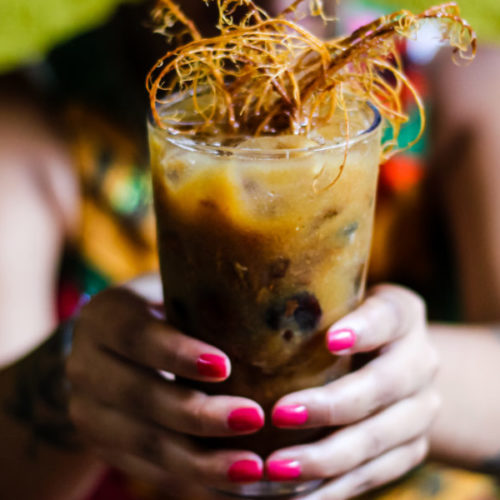
Tamarind has an acidic and sweet taste and is very good for your health. What do you think about a gastronomic immersion in the heritage kitchen of the state of Bahia, while sipping a tamarind drink? Dona Mariquita Restaurant brings to the table dishes such as maniçoba, xinxim and jackfruit palm hearts. It is the perfect opportunity to enjoy the local cuisine and learn more about our culture. Discover this restaurant on this link.
Curiosities
Tamarind is also known as “tâmara da Índia” (Indian date). It is a food of African origin, although it is mainly cultivated in India. The tree can grow naturally in tropical and subtropical climate regions. It has flowers that are yellow and red.
In Brazil, tamarind cultivation occurs in almost all states, and it is consumed mainly in the North and Northeast regions.
Seriguela – roska or popsicle?
Ciriguela, ceriguela, siriguela or seriguela. You will find the spelling of this fruit in different ways on the internet, and also in advertisements found in street markets and markets in the city. The seriguela, quite common in the Northeast region of Brazil, is also called ameixa da Espanha (Spanish plum), cajá vermelho, jacote, among others. So, relax and don’t worry about the spelling, because no matter how you spell it, it’s really yummy! And those who are not from Salvador, will return home dying for a popsicle, ice cream or roska made with it.
Seriguela is a fruit with a sweet flavor, a little sour, it is small and its color goes from green, turning yellowish to a very strong red when ripe. You can find this fruit anywhere and it is excellent for an unforgettable roska. So the tip is this: when choosing the fruit for your drink, don’t say lemon, kiwi or strawberry. Prefer the seriguela, seriously! In Rio Vermelho, known as the most bohemian neighborhood in the city, two restaurants stand out in this drink: La Taperia and Pasta em Casa.
If you prefer an ice cream facing the sea, go to Sorveteria da Barra. Jabuticaba, seriguela and tamarind are part of the “Sabores da Bahia” line. They do not stay all year, only when it’s the right season (summer), when the harvest will be in its best quality, for sure. On the tropical fruit menu, there are also flavors of green coconut, cajá, mango, mangaba, cupuaçu, pineapple, tangerine, guava, soursop and jackfruit.
Curiosities
The cirigueleira is a medium-sized tree, reaching up to seven meters in height. It comes from Mexico, Central America and/or South America. The fruit can be consumed fresh or in the form of juices, popsicles, ice cream, wines, liqueurs, jellies, soft drinks and sweets.
Seriguela contains antioxidants that fight free radicals that damage cells and fibers responsible for lowering cholesterol levels. It’s also good for the gut. In addition, it is rich in carbohydrates, vitamins A, B and C, iron, calcium and phosphorus.
Biribiri – fruit on the hamburger, can it be?
Biribiri is very green and has medicinal properties. It is normally consumed as a substitute for lemon in Bahian cuisine, but the Bahians’ creativity went further. Here, it has turned into a pickle and is part of the ingredients of one of Bravo Burger’s hamburgers, one of the best in the business in Salvador.
You can also find this fruit in tropical flavors in the best ice cream parlors in the city, or fresh in open markets such as Feira de São Joaquim, Mercado de Itapuã, Novo Mercado São Miguel, Ceasinha at Rio Vermelho, among others.
Curiosities
Biribiri or limão-de-caiena (cayenne lemon) is a tropical fruit that has its origins in Asia. In addition to being consumed naturally, it can be used in the preparation of salads, jams, jellies, vinegars, caipirinha and wines. We can also use it in the preparation of ceviche, or eat as a snack, cut into slices and added with salt.
Mangaba – a classic Salvador flavor
In open markets and ice cream carts around Salvador, you will find mangaba. This is a fruit from sandy terrain that is loved by Bahians and by those who come to Bahia. In popsicles, geladinhos or ice cream, mangaba is a classic.
Curiosities
Mangaba is the fruit of the mangabeira, also called mangaba-ovo. It is edible and used in the manufacture of juices, ice cream, sweets and beverages. Its flavor is slightly acidic, and at the same time delicate, with a thin skin and whitish pulp.
The mangabeira is a tree that can reach seven meters in height, belonging to the Apocinaceae family. It is native from Brazil, and can be found from the north to the southeast. It also grows in Paraguay and eastern Peru.
Fruta-pão (Breadfruit) – you will be amazed
The breadfruit is big, round like a melon and weighs up to 3 kilos. Its skin is yellowish-green and its pulp is dark yellow in the fruits with no seeds and brownish in the seed variety. No-seed fruits are rich in starch, proteins and vitamins and can be eaten cooked, baked, in sweets or even fried.
One of the most renowned restaurants in Salvador, known for its dishes full of northeastern ingredients – used in ways never thought of, Origem has already had in its menu a creation using the fruit: VG shrimp with breadfruit vatapá and chestnut farofa. It won’t take long till they create a new version for the fruit. It’s worth knowing it.
The plant originates from the Pacific Islands, Indomalasia (Java or Samatra) or Malaysia. It grows above 12 m and has adapted very well to the climate of the Brazilian Northeast. It is found from Pará to São Paulo.
Breadfruit is eaten boiled with water and salt or roasted. It is popular in some vegetarian dishes and is known for its high nutritional value and culinary versatility.
By Fernanda Slama
Content coordinator of the Visit Salvador da Bahia portal

